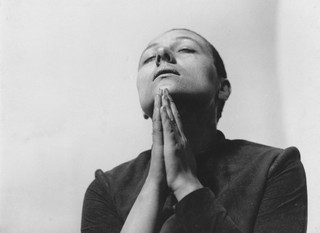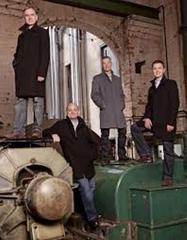|
Back
The Passion Without the Passion New York
Miller Theater, Columbia University
10/14/2015 - & October 16, 2015
Donald Greig: Medieval Music Devised and Developed for Carl Dreyer’s La Passion de Jeanne d’Arc
Orlando Consort: Matthew Venner (Countertenor), Mark Dobell, Angus Smith (Tenors), Donald Greig (Baritone), With Robert MacDonald (Bass)

R. Falconetti as Saint Joan (© Miller Theater)
“We didn’t need music. We had faces!” Gloria Swanson in Billy Wilder’s Sunset Boulevard (adapted)
Is it coincidence or an Act of God, that the two finest movies ever made about Christianity are both showing this week in New York? On Sunday, the poet-translator Norman McAffee is showing and lecturing on The Gospel According to Saint Matthew by Pier Paolo Pasolini at Jefferson Market Library.
Last night, Miller Theater showed a version of Carl Dreyer’s 1927 “silent” film, The Passion of Saint Joan. But this version wasn’t silent at all. And that, to this passionate lover of the film, was problematic.
An explanation is due. The splendid British vocal quartet, Orlando Consort (with an additional baritone), has provided music for Dreyer’s 1927 masterpiece, a movie which, in its original form, has been a major influence on every serious cinema director. Dreyer’s later films were rather ponderous, but Passion of Saint Joan moves quickly, with thousands of editorial cuts in its 95-minute duration. With an astounding court scene, with vivid torture, and with a stake-burning that could have inspired the ISIS burning of the Jordanian pilot earlier this year.
This original film relied not only on closeups of Joan, but her,freakish, cruel, zealous, ugly, astoundingly frightening interrogators. On the villagers who revile and love her, with significant trivia (a girl on a swing in the background of the burning, a freak show). Even the appearance of the great French philosophe Antonin Artaud as a sympathetic priest.
The movie makes its own music.
The Orlando Consort creations, as part of Miller Theater’s “Early Music Series”, were historically appropriate and geographically right. No listing was given in the program, but they included early 15th Century pieces by Loqueville, Dufay, Dunstable, Binchoise. the Agincourt Carol, O Redemptor, and–most wonderful of all–Christine de Pizan’s La Ditié de Jeanne d’Arc.
Even more important, they were joined with the movie in mind. David Greig had chosen and developed the selections with care, tenderness and authenticity. The Orlando Consort sung and chanted with nuance, the film tensions were respected, and Mr. Greig was especially creative in balancing music, silence, and the chanting of Latin when pertinent.
And how I wish I could praise this obvious labor of love and scholarship. Yet a personal caveat makes this difficult. Every since being spellbound when first seeing The Passion of Saint Joan as a child, I have managed to watch the original Carl Dreyer 1927 film once a decade. And while hardly appalled by the musical addition, I was somewhat depressed at the outcome.
This is a major shortcoming, but we all share it. Scholars today know that the pristine white Athenian buildings from the Age of Pericles were originally painted in bright shining colors. But who would want to see the Parthenon looking like something from Disneyland?
And we know that the “characteristic” shadows, darkness and forbidding corners of 1940’s film noir are because the smaller film studios didn’t have the MGM money to make the color-movies they might have preferred. Yet who would trade the gritty charcoal looks of Alan Ladd and Robert Mitchum for a cheerier Technicolor visual?
Carl Dreyer also wanted The Passion of Saint Joan to have sound. But the Danish perfectionist couldn’t find the right audio equipment. He already had the best possible script–the original Inquisitorial Transcript of 1430–and he had, in an unlikely stage actress, Renée Maria Falconetti, a Joan whose homely, agonizing, singularly haunting face could not even be duplicated by Ingrid Bergman in her “Joan” three decades later.

Orlando Consort (© Courtesy of the Artists)
Mr. Greig was diligent in marrying the visual with the aural. When a priest reads the sanction against Saint Joan, the Orlando Consort chants rather than sings. (I assume the chant is identical to the Latin opprobrium.) When Joan is at her most agonizing, her most confused, the Orlando Consort ceases music, and the silence is almost deafening.
Yet one may ask whether auditorially “coloring” this movie was really a virtue. The program says that Joan would probably have heard the same music in her own church. But Joan did not go to the great old cathedral in Rouen. She was a village girl who was taught the Lord’s Prayer–as the film says–not by a priest but by her mother. The church in Domrémy had no choir, probably no organ. Her music would have been elementary, childlike.
Even more disturbing was that the Orlando Consort music became background music. Elevator music. Outside of stylized movies (like Alexander Nevsky), music is not supposed to be heard. And Dreyer’s faces were so powerful, his whole film so fierce that music was either unheard or distracting.
At a certain point, I simply didn’t listen. Consciously turning off these vocalists (or trying to), I watched the movie at face value. Literally face value. My respect for David Greig and the Orlando Consort is great. But one does not respect Dreyer’s great film. One must be overwhelmed by it power, its gentleness, and, at times, its ferocity.
At a later century, Claudio Monteverdi would have been able to duplicate the emotions of this film. His own operas were like Dreyer’s film in offering direct excitement, unfiltered emotion fear and compassion. Not last night. The movie still has its power, but that power can only be dminished when dulcet tones and noble motets replace, quite literally, the Passion of the Cross.
Harry Rolnick
|